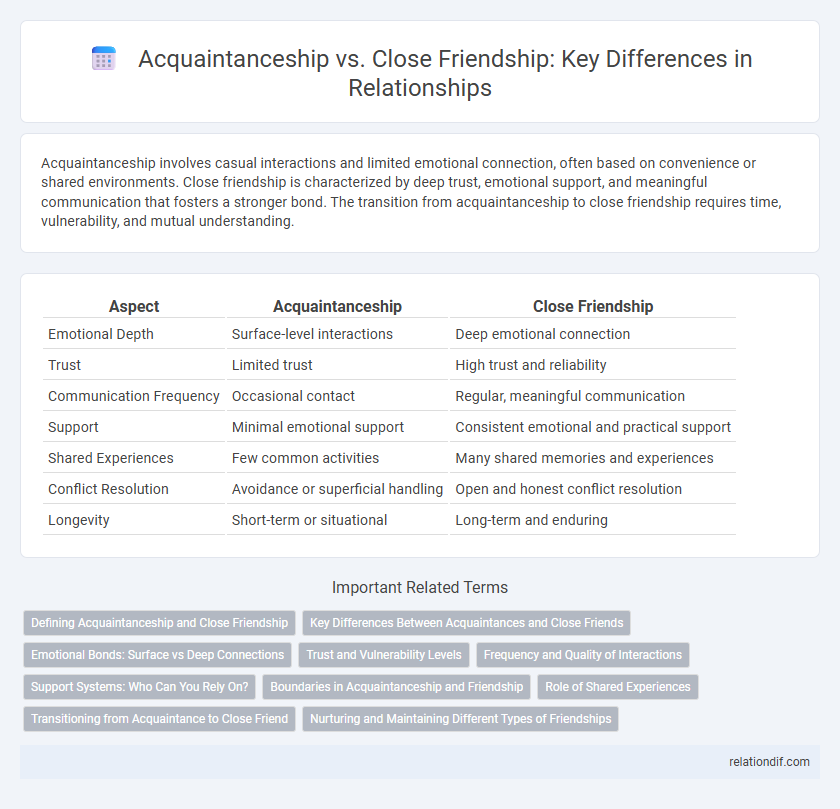Acquaintanceship involves casual interactions and limited emotional connection, often based on convenience or shared environments. Close friendship is characterized by deep trust, emotional support, and meaningful communication that fosters a stronger bond. The transition from acquaintanceship to close friendship requires time, vulnerability, and mutual understanding.
Table of Comparison
| Aspect | Acquaintanceship | Close Friendship |
|---|---|---|
| Emotional Depth | Surface-level interactions | Deep emotional connection |
| Trust | Limited trust | High trust and reliability |
| Communication Frequency | Occasional contact | Regular, meaningful communication |
| Support | Minimal emotional support | Consistent emotional and practical support |
| Shared Experiences | Few common activities | Many shared memories and experiences |
| Conflict Resolution | Avoidance or superficial handling | Open and honest conflict resolution |
| Longevity | Short-term or situational | Long-term and enduring |
Defining Acquaintanceship and Close Friendship
Acquaintanceship refers to a casual relationship characterized by limited interaction and superficial knowledge of one another, often based on occasional contact or shared environments. Close friendship involves deep emotional connection, trust, frequent communication, and mutual support, distinguishing it from the more impersonal nature of acquaintanceship. The intensity and quality of interactions are key factors that define the spectrum from acquaintanceship to close friendship.
Key Differences Between Acquaintances and Close Friends
Acquaintances typically share limited personal information and interact in specific contexts, whereas close friends engage in deep emotional connections and frequent, meaningful communication. Trust levels vary significantly, with close friends providing reliable support and confidentiality unlike acquaintances who maintain surface-level interactions. Shared experiences and vulnerability are foundational to close friendships, distinguishing them from the casual, often situational nature of acquaintanceship.
Emotional Bonds: Surface vs Deep Connections
Acquaintanceship involves surface-level emotional bonds characterized by polite interactions and limited personal disclosure, often confined to shared environments or activities. Close friendship fosters deep connections through trust, vulnerability, and mutual support, allowing for authentic emotional exchange and understanding. These deep emotional bonds contribute to stronger relational resilience and a sense of belonging that acquaintanceship typically lacks.
Trust and Vulnerability Levels
Acquaintanceships involve low levels of trust and minimal vulnerability, as interactions remain surface-level and superficial. Close friendships are characterized by deep trust, allowing individuals to openly share personal thoughts and feelings, fostering emotional intimacy. Higher vulnerability in close friendships enhances mutual understanding and support, creating stronger, more resilient bonds.
Frequency and Quality of Interactions
Acquaintanceship typically involves infrequent and surface-level interactions that focus on casual or situational exchanges. Close friendships are characterized by frequent, meaningful interactions that foster deep emotional connections and trust. The quality of these interactions significantly influences the strength and longevity of the friendship.
Support Systems: Who Can You Rely On?
Close friendship provides a robust support system with deep emotional trust, consistent availability, and genuine empathy, making it easier to rely on during challenging times. Acquaintanceship offers limited support, often restricted to casual interactions and occasional assistance without the same level of emotional depth or commitment. Trustworthiness, frequency of contact, and mutual understanding distinguish reliable close friends from acquaintances in any social support network.
Boundaries in Acquaintanceship and Friendship
Boundaries in acquaintanceship often involve limited personal disclosure, maintaining a polite distance with interactions centered around casual or situational contexts. In close friendships, boundaries become more flexible as trust deepens, allowing for emotional vulnerability and shared experiences. Respecting these evolving boundaries ensures mutual comfort and strengthens the bond between friends.
Role of Shared Experiences
Shared experiences play a pivotal role in transforming acquaintanceship into close friendship by fostering trust and emotional connection. Engaging in meaningful activities or overcoming challenges together deepens understanding and mutual support, which casual interactions lack. This bonding process creates a foundation for long-lasting, intimate relationships driven by empathy and shared memories.
Transitioning from Acquaintance to Close Friend
Transitioning from acquaintance to close friend involves building trust through consistent, meaningful interactions and shared experiences that deepen emotional connection. Open communication and vulnerability play critical roles in moving beyond superficial knowledge to a genuine, supportive bond. This progression often requires time, mutual effort, and a willingness to invest in the relationship's growth.
Nurturing and Maintaining Different Types of Friendships
Nurturing acquaintanceship relies on casual interactions and shared environments, requiring minimal emotional investment but regular contact to maintain familiarity. Close friendship demands deeper emotional support, trust, and open communication, with consistent efforts to understand and respond to each other's needs. Balancing time and energy between these types ensures a diverse social network that supports both casual connections and meaningful bonds.
Acquaintanceship vs Close friendship Infographic

 relationdif.com
relationdif.com